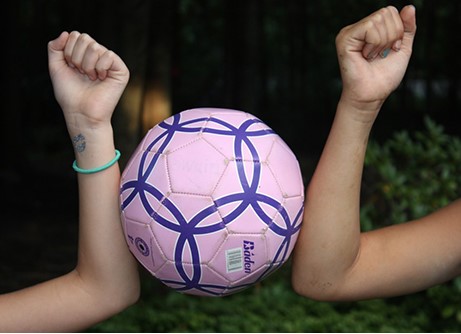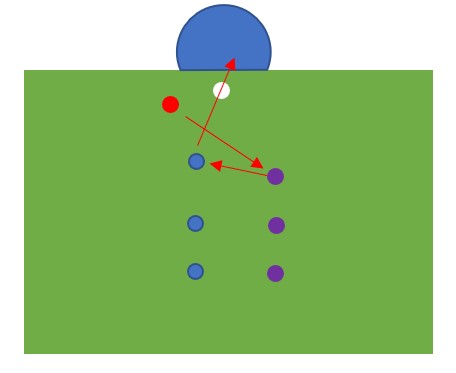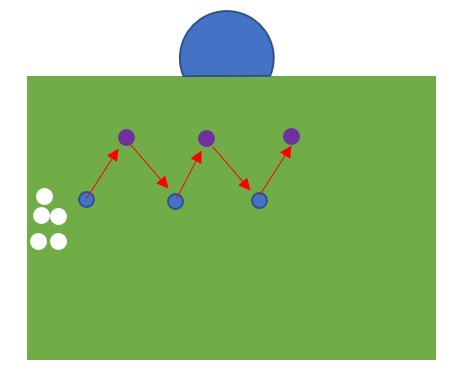What Is Teamwork, In Soccer?
What is Teamwork, In Soccer
For the Kids:
One person does not make a team. Players have different skills and experiences. Some can kick better, some can communicate better, some can defend better. And it takes all of those people working together to make a winning team!
Coach's Corner - A few words about teamwork: When you have a team that has been playing together for years, a bond and synergy is built between players that can dramatically increase the overall success of the team. With new players, it’s crucial to integrate them into the team not only so they feel welcome, but so they also add to the team value.
- Set Expectations - There may be similar positions in soccer and intersecting roles, but each player functions independently and has a specific job on the field. With each player, make sure they are clear on their exact role and what is expected of them. Take time to ensure they understand how their position interacts with other players on the field. In addition to this, make sure each player understands their responsibilities to the team. This starts with them being held accountable for bringing their proper equipment to practices and games.
- Build Trust in Each Other - Assigning individual responsibilities won’t work without the players’ trust in each other. Every player on the team should know that their teammates will fulfill their corresponding roles. You can integrate trust-building into your coaching strategies by allowing training to be the time spent with teammates they’re least close to. Pairing them up during conditioning and adding a little competitive play during training will force them to rely on and work with each other to achieve a goal together.
- Create a Solid Communication System - Playing soccer is as much about improvisation as it is about strength and skills. You can’t control how the opposite team will perform, so your team needs to adjust accordingly. As a coach, it’s your job to let your players know exactly what they need to do in every possible situation. This way they don’t even need to talk on the field. A solid communication system doesn’t only refer to verbal communication, but also visual cues and sensitivity to each other’s body language on the field. Simple eye contact, for example, will clue them in on the same strategy you taught them in training. Good communication also needs to exist off the field. Conducting team meetings every once in a while and open forums when needed are important so your players will get comfortable about voicing concerns, feedback, and settle misunderstandings with each other.
- Empower Each Member Equally - Favoritism is one way of developing unspoken grudges between teammates and it separates them more. You might encourage the opposite of working together by focusing praises on the star players. Even if the new players are not as good yet, recognizing when they’re doing the right thing can do heaps for their self-esteem and motivation to do better.
- Set Goals for the Team to Strive for Together - Camaraderie forms organically when a group of people is driving towards the same goal. Set small wins and big goals that your team can work towards. For one, the pressure and weight of the goal will be equally distributed among them. Hustling won’t feel as heavy on the individuals. Simultaneously, achieving them will feel that much sweeter when they know they worked for it together. The celebration is grander.
- Encourage Players to Build a Personal Bond - Encourage your players to know each other beyond the field. When they have knowledge of each other’s lives outside of training, they’ll have a better understanding of each other’s struggles. They’ll also find similarities among themselves, be it life situations or simple mannerisms, that will form a deeper connection than just being teammates.
Conclusion - Playing soccer is a team sport. Naturally, it won’t work out in any team’s favor if the players themselves are not in sync with their intention, goals, and motivation. These tips are something you can incorporate in your coaching techniques to strengthen the team’s personal foundation.
Teamwork Game 1
Teamwork Game 1
 Chain Gang
Chain Gang
In this game, you build camaraderie and physical skills. To avoid becoming the “weakest link” and breaking the chain, players have to work their strength and balance.
To begin, place several cones onto the field (in a row – spaced apart).
One player begins by kicking the ball down the field (and back) in between and around the cones. When they get back to the starting line, they link arms with the second participant and repeat the course. The game continues until all children are linked together and have completed the course. Ask them to navigate the turns without breaking the chain. If they do, they must start again.
Encourage them to talk to each other to decide how they can do the course without “breaking the chain”.
Variation: If you’d like to add other “obstacles or challenges” to the course, feel free.
Teamwork Game 2
Teamwork Game 2
 Wacky Carry
Wacky Carry
Two children carry a soccer ball down a path using designated body parts between the two children.
Create a Square out of cones for the kids to move about in a clockwise fashion. Then pair up the kids by similar heights.
As the partners navigate around the outside of the square, there will be a different challenge for them to perform.
- Side 1: The children carry a soccer ball pushing against each other with the ball between their backs.
- Side 2: Forehead to forehead
- Side 3: Palm to Palm
- Side 4: Belly to Belly
Variation: Feel free to come up with other wacky ways to carry the ball together!
Teamwork Game 3
Teamwork Game 3
 Stick Together
Stick Together
Watch this video to get an idea of what we’ll be doing. https://www.youtube.com/watch?v=XJxRJkfppL4
Since our audience is young and we don’t want kids to “sit it out”, we’ll be doing a variation of this game. Have all children hold hands, in a line.
The coach will then kick the ball around and the kids will try to “take it from the coach” and kick toward the goal. Do not focus so much on actually making a goal. The point is that they are working as a team to steal the ball and kick it in a general direction.
You can decide how aggressive or sneaky you want to be with keeping the ball away from them. We do however recommend giving them the opportunity to “steal” it from you so they can see what it’s like to work as a team.
Variation: Pair up all kids and have them try to steal the ball from each other.
Note: We do not condone “clotheslining” anyone. If you feel it would be helpful, mention this at the start of the activity.
Why is Passing Important?
Why is Passing Important
For the Kids: Passing the ball can be a good option. When your path forward is completely blocked and you can't get through, passing the ball might be your only choice. Try to keep your head up when passing the ball so that you can see if your teammate is still there.
Coach's Corner: The best soccer players are often the best passers of the ball. At this age however, it's more important to learn the fundamentals of having ball control and dribbling. Many times having instinct and thinking ahead, etc are not something that 4, 5 and 6 year olds have in their toolbox. This is definitely a controversial topic in the soccer world - you'll hear some coaches state that kids MUST pass at least once before kicking it in the goal. This can often force kids to pass when passing is not necessary - resulting in them giving up the ball.
Passing Tips:
-
Develop vision - Vision is how well you can see potential passes. Effective passers have good technique and vision.
-
Master every type of pass - Many options open up when you learn every type of pass. As the child progresses through the HOVSA program, they will learn more kinds of passes and when to use them.
-
Use the through pass - To perform a “through pass” pass the ball ahead of your target into space. Your teammate will run to the pass.
-
Don't underestimate the simple pass - Retaining possession is as simple as finding open teammates close to you and passing the ball. Playing a simple pass is often your best option. Passing the ball around annoys and tires the defense, creating gaps that you can exploit.
-
Pass often - Many players dribble far too often. Dribbling is tiring, makes getting injured more likely, and allows defenders to get back on defense. Dribbling has it’s place, but passing is a better option in most situations.
-
Pass Fast - The faster you pass the ball, the less time the opposition has to mark you and your teammates. Good players make good passes fast. Making fast passes requires good awareness, passing technique, ball control, first touch, and vision. This skill takes time to learn.
-
Get a partner - If you are serious about improving your passing technique pass outside of practice. Find a partner that will pass with you on a consistent basis. You will improve your passing ability quicker than other players.
-
Master correct pace - Putting correct pace on the ball is tough to master but vital to improving your passes.
Passing Game 1
Passing Game 1
 Hot Potato
Hot Potato
Have children stand in a circle (spread apart). Use 1 ball.
Child 1 kicks the ball to someone else in the circle. That person immediately kicks it to another kid – like it’s a hot potato.
Note: They should concentrate on kicking with the side of their foot and know how hard/ soft to kick it.
Variation: Use 2 balls at the same time.
Passing Game 2
Passing Game 2
 Pass Kick Score!
Pass Kick Score!
Have children stand in 2 lines. Facing the goal – maybe about 10-15 away from it.
Coach will kick the ball to the first person in line 1. That kid will kick it to first person in line 2. That person will kick it into goal.
Both children will then go to the back of the other line and wait their turn again.
Note: Consider doing this one mulitple times to get the feel for passing - maybe speeding it up or going really slow to work on the fundamentals of kicking (using the side of your foot). Again, do not focus too much on whether they actually get a goal or not.
Passing Game 3
Passing Game 3
 Zig Zag Pass
Zig Zag Pass
Have children stand in 2 lines – spread apart.
1st player kicks to ball to player 2 – player 2 kicks to player 3 – player 3 kicks to player 4 and so on.
Player 1 will then take another ball and repeat.
Variation: speed up how fast Player 1 is starting to send out the ball – so that there are multiple balls going in a zig zag line at the same time.
